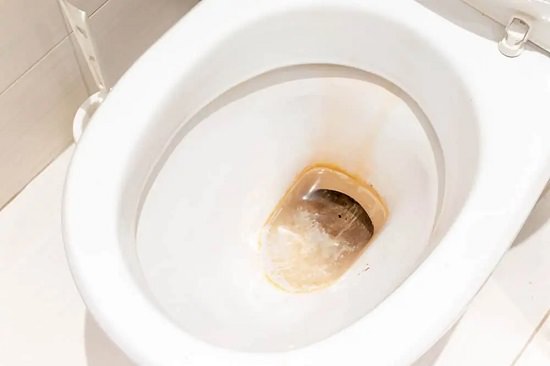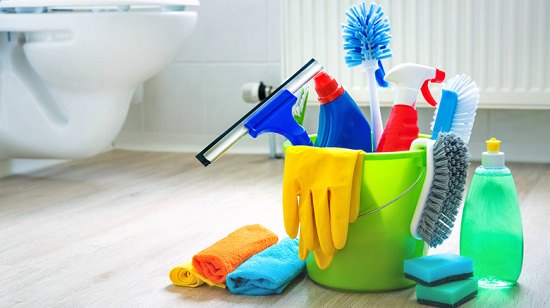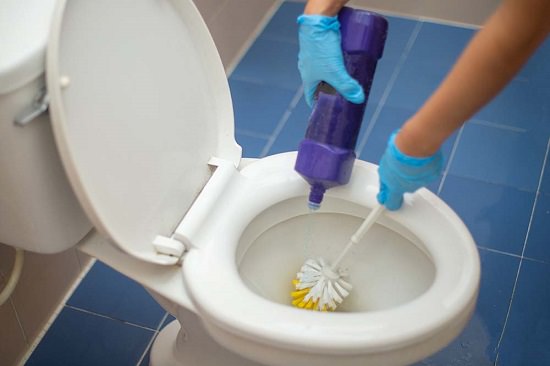Stop playing with your health by ignoring black toilet rings. Here’s all about how to clean toilet rings effectively and ignore getting them!
Toilet rings or toilet stains are discolorations and deposits that accumulate on the inside surface of a toilet bowl over time. These rings can be unsightly and typically occur because of a combination of mineral deposits, hard water stains, and organic matter such as bacteria and mold.
A black toilet ring or black stains in a toilet bowl can occur due to several reasons, most commonly related to the growth of mold, mildew, or certain types of bacteria. Here are some common causes:
1. Mold and Mildew
Mold and mildew thrive in damp, humid environments, making the inside of a toilet bowl an ideal breeding ground. When these microorganisms grow, they can form dark, black, or greenish-black stains. Mold and mildew are often more common in bathrooms with poor ventilation or in toilets that are not in use frequently.
2. Bacterial Growth
Certain types of bacteria, such as sulfur bacteria, can produce black or dark-colored stains. This happens when they interact with minerals and organic matter in the toilet bowl. These bacteria are more likely to be present in water with high sulfur content, which can have an unpleasant odor.
3. Mineral Deposits
Mineral deposits like limescale and calcium typically create white or off-white stains. However, they can sometimes become discolored due to the presence of other substances. These substances can be anything such as organic matter or chemical reactions in the water. Such discolored deposits might appear black or dark brown.
4. Old Stains
Over time, old and stubborn stains in a toilet bowl can become discolored, turning darker and appearing black or nearly black.
How Long Does It Take for Black Toilet Ring to Develop?
The time it takes for a black toilet ring to occur can vary depending on several factors, including the specific conditions in your bathroom and the quality of your water supply. Here are some factors that can influence how quickly black toilet rings develop:
- Frequency of Use: Toilets that are frequently in use are less likely to develop black toilet rings. Because regular flushing can help prevent the buildup of organic matter, mold, and bacteria.
- Bathroom Environment: Bathrooms with poor ventilation, high humidity levels, and limited natural light are more conducive to the growth of mold, mildew, and bacteria, which can contribute to black stains.
- Water Quality: If your water supply contains high levels of sulfur or other minerals, it may encourage the growth of certain types of bacteria that can produce black stains.
- Cleaning Habits: Regular cleaning and maintenance of the toilet bowl can help prevent the development of black stains. Neglecting cleaning for an extended period can lead to the formation of stubborn stains.
- Local Conditions: The rate at which black toilet rings form can also depend on the climate and local environmental conditions. In areas with high humidity and warm temperatures, mold and mildew growth might accelerate.
Generally, if you regularly clean and maintain your toilet bowl, you can prevent or significantly delay the formation of black stains. However, in bathrooms with poor ventilation or in homes with water quality issues, black stains might develop more quickly. It’s a good practice to clean your toilet regularly to keep it clean and prevent the buildup of stains and odors.
Health Concerns
A black toilet ring can potentially pose health concerns and serve as a breeding ground for infections if left unaddressed. Here’s why:
1. Mold and Mildew
Mold and mildew thrive in damp, dark environments, making the interior of a toilet bowl an ideal breeding ground. While most molds and mildews are not directly harmful to humans, some people may be sensitive or allergic to mold spores, which can be released into the air when disturbed. Prolonged exposure to mold spores in the bathroom can lead to respiratory issues, allergies, or skin irritation in susceptible individuals.
2. Bacteria
Certain types of bacteria, including those that produce sulfur compounds, can create black or dark-colored stains in toilets. These bacteria can contribute to unpleasant odors in the bathroom and may potentially cause health issues if they come into contact with skin or mucous membranes. While the risk of infection from these bacteria is generally low, it’s still best to keep your toilet clean and free of such stains.
3. Hygiene Concerns
A toilet with visible stains, especially black ones, may indicate poor hygiene and cleanliness. This can be a source of concern. As it may encourage the spread of germs and bacteria in the bathroom, potentially leading to cross-contamination with other surfaces or objects.
How To Clean Toilet Rings
DIY Toilet Bowl Cleaner Spray
Creating a DIY toilet bowl cleaner spray is a cost-effective and environmentally friendly way to keep your toilet clean. Here’s a simple recipe using common household ingredients:
Ingredients
- Baking Soda: 1/2 cup
- Water: 1/2 cup
- Liquid Castile Soap: 1/4 cup
- Essential Oils (optional): A few drops for fragrance (e.g., tea tree oil, lavender oil, lemon oil)
Instructions
- Prepare a Spray Bottle:
- Find a clean, empty spray bottle. Make sure that you clean and rinse it thoroughly to remove any previous residues.
- Mix Baking Soda and Water:
- In a mixing bowl, combine 1/2 cup of baking soda and 1/2 cup of water. Stir until the baking soda has mostly dissolved.
- Add Liquid Castile Soap:
- Pour 1/4 cup of liquid castile soap into the mixture. Castile soap is a natural and gentle soap that helps with cleaning.
- Add Essential Oils (Optional):
- If you want to add a pleasant fragrance and some extra cleaning power, add a few drops of your favorite essential oil. Tea tree oil is a popular choice for its natural antibacterial properties, but you can use others as well like lavender, lemon, or eucalyptus for a pleasant scent.
- Stir and Transfer:
- Mix the ingredients thoroughly until well combined. Then, use a funnel to pour the mixture into the empty spray bottle.
- Label the Bottle:
- Label the spray bottle with the contents and usage instructions. This is especially important if you plan to store it alongside other cleaning products.
Usage
To use your DIY toilet bowl cleaner spray:
- Shake the bottle before each use to ensure the ingredients are well mixed.
- Spray the cleaner liberally inside the toilet bowl, covering the entire surface, including under the rim.
- Allow the cleaner to sit for a few minutes to loosen stains and grime.
- Use a toilet bowl brush to scrub the bowl thoroughly, paying attention to stained or soiled areas.
- Flush the toilet to rinse away the cleaner and reveal a clean, refreshed toilet bowl.
This DIY toilet bowl cleaner is effective, eco-friendly, and doesn’t contain harsh chemicals. It’s safe to use and can be a great addition to your cleaning routine. Adjust the fragrance and cleaning power by experimenting with different essential oils and their quantities until you find the scent you prefer.
Maintaining a clean and hygienic toilet is essential for the overall cleanliness and health of your bathroom and household.




